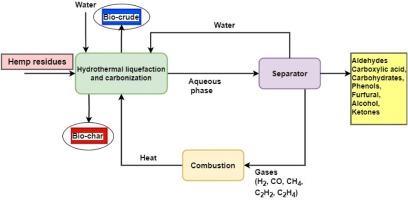工业大麻残留物的热化学增值:生物燃料和化学品的水热转化进展
IF 5.8
2区 生物学
Q1 AGRICULTURAL ENGINEERING
引用次数: 0
摘要
工业大麻残留物的价值通过热化学过程代表了一个有前途的途径,可持续生物质转化和废物管理。本文综述了工业大麻残基热化学增值的最新进展和策略,重点介绍了工业大麻残基通过热液液化和碳化转化为生物炭、生物化学品和生物燃料等有价值产品的研究进展。讨论了其他各种热化学过程,包括热解、气化和焙烧,强调了它们将大麻残留物转化为高能量燃料和高价值化学品的潜力。不同的加工途径探索工业大麻从收获到生物燃料的残留物利用的潜力是详细的。阐明了工艺条件、催化剂和生物质特性对产品收率和质量的协同效应,为提高工艺效率和产品选择性的优化策略和挑战提供了见解。然而,50/50 v/v的乙醇-水被认为是最佳大麻共溶剂液化的一个很好的参考值。讨论了大麻的市场潜力及其对世界经济的影响。到2030年,全球工业大麻市场预计将达到近60亿美元。此外,建议大麻渣增值的环境影响和技术经济可行性作为未来评估的一些领域,强调整体可持续性评估对指导未来研究和工业实施的重要性。总的来说,这篇综述强调了热化学增值的重要性,特别是水热液化和碳化,作为一种利用大麻残留物未开发潜力的通用和可持续的方法,从而有助于向生物基循环经济过渡。本文章由计算机程序翻译,如有差异,请以英文原文为准。

Thermochemical valorization of industrial hemp residues: Advances in hydrothermal conversion for biofuels and chemicals
The valorization of industrial hemp residues through thermochemical processes represents a promising avenue towards sustainable biomass conversion and waste management. This study presents a comprehensive review of recent advancements and strategies in the thermochemical valorization of industrial hemp residues, focusing on their transformation into valuable products such as biochar, biochemicals and biofuels through hydrothermal liquefaction and carbonization. Other various thermochemical processes including pyrolysis, gasification, and torrefaction are discussed, highlighting their potential for converting hemp residues into energy-rich fuels and high-value chemicals. Different processing pathways for exploring the potential of industrial hemp from harvesting to the residue utilizations for biofuels are detailed. The synergistic effects of process conditions, catalysts, and biomass properties on product yields and quality are elucidated, offering insights into optimization strategies and challenges for enhancing process efficiency and product selectivity. However, a 50/50 v/v ethanol-water is considered a good reference value for optimal hemp co-solvent liquefaction. The market potential of hemp is discussed and its impact on the world economy. The global industrial hemp market is projected to reach almost USD 6 billion by 2030. Furthermore, the environmental implications and techno-economic feasibility of hemp residue valorization are suggested as some of the areas for future evaluation, emphasizing the importance of holistic sustainability assessments in guiding future research and industrial implementation. Overall, this review emphasizes the significance of thermochemical valorization especially hydrothermal liquefaction and carbonization as a versatile and sustainable approach for harnessing the untapped potential of hemp residues, thus contributing to the transition towards a bio-based circular economy.
求助全文
通过发布文献求助,成功后即可免费获取论文全文。
去求助
来源期刊

Biomass & Bioenergy
工程技术-能源与燃料
CiteScore
11.50
自引率
3.30%
发文量
258
审稿时长
60 days
期刊介绍:
Biomass & Bioenergy is an international journal publishing original research papers and short communications, review articles and case studies on biological resources, chemical and biological processes, and biomass products for new renewable sources of energy and materials.
The scope of the journal extends to the environmental, management and economic aspects of biomass and bioenergy.
Key areas covered by the journal:
• Biomass: sources, energy crop production processes, genetic improvements, composition. Please note that research on these biomass subjects must be linked directly to bioenergy generation.
• Biological Residues: residues/rests from agricultural production, forestry and plantations (palm, sugar etc), processing industries, and municipal sources (MSW). Papers on the use of biomass residues through innovative processes/technological novelty and/or consideration of feedstock/system sustainability (or unsustainability) are welcomed. However waste treatment processes and pollution control or mitigation which are only tangentially related to bioenergy are not in the scope of the journal, as they are more suited to publications in the environmental arena. Papers that describe conventional waste streams (ie well described in existing literature) that do not empirically address ''new'' added value from the process are not suitable for submission to the journal.
• Bioenergy Processes: fermentations, thermochemical conversions, liquid and gaseous fuels, and petrochemical substitutes
• Bioenergy Utilization: direct combustion, gasification, electricity production, chemical processes, and by-product remediation
• Biomass and the Environment: carbon cycle, the net energy efficiency of bioenergy systems, assessment of sustainability, and biodiversity issues.
 求助内容:
求助内容: 应助结果提醒方式:
应助结果提醒方式:


